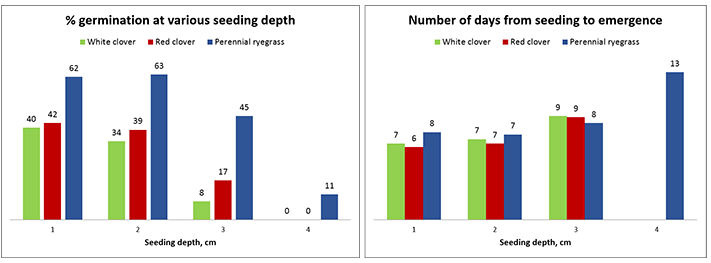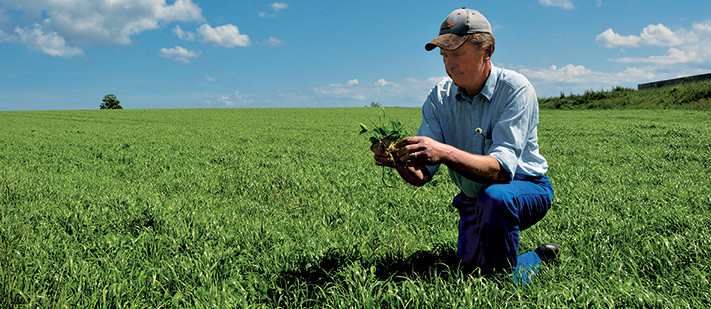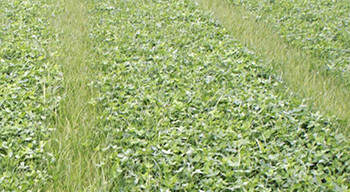Boost dairy-farm output with sound clover management
The feed value of a field of clover-grass – a mixture of forage grass and clover – is higher than for a field of pure grass. Clover-grass raises milk yields. Clover also fixes nitrogen, which means that subsequent crops need less fertiliser. In short, clover boosts income when used as fodder, and reduces the cost of crops grown in the following years.
18/03/2016
Clover-grass improves profitability twice over
The table below shows that clover-grass increases feed intake by as much as 1,8 kg dry matter per cow per day. And that raises Energy Corrected Milk (ECM) yields by as much as 4,5 kg per cow per day compared to pure grass silage.
Incresased feed intake with clover grasss |
||||
|---|---|---|---|---|
| Pure ryegrass | Red clover grass | White clover grass | Alfalfa | |
| % digestibility of dry matter (DM) | 72 | 69 | 72 | 64 |
| Silage intake (kg DM/cow/day) | 11,4 | 12,9 | 13,2 | 13,6 |
| kg milk (ECM)/cow/day | 26,5 | 31,0 | 30,7 | 29,3 |
Dewhurst, 2003
In a field of clover-grass, the clover roots store up to 250 kg of nitrogen per hectare. In subsequent years, as the nitrogen is released, you need less bagged fertiliser. For example, a crop of maize or cereals planted in the season after clover-grass utilises the nitrogen and when you also include a grass catch crop, this will counteract the risk of nitrogen leaching.
To get the best milk and nitrogen yields from your clover-grass, manage it as an active component of your sward:
- Sow your clover-grass no deeper than 1,5 cm
- To prevent grass taking over, do not add too much nitrogen fertiliser
- Keep to fixed driving lanes in the field because clover does not like to be driven on
- If you must spray to counteract weeds, use chemicals that clover tolerates
Shallow sowing and well-timed cuts improve establishment

Field trials in Denmark
Sow clover-grass in spring or late summer. For late-summer sowing make sure there is plenty of time for the clover to establish well before winter. Support late-summer sowings with a moderate application of nitrogen fertiliser during the following spring before the first cut. Nitrogen helps the clover compete with the grasses in your mixture. Especially too much nitrogen added to the mixture before first cut supports the grass compared to clover. Then grass will take over and depress the clover in your mixture. Especially too much nitrogen added to the mixture before first cut supports the grass compared to clover. Then grass will take over and depress the clover in your mixture. A typical application should be 40-60 % of the total amount of nitrogen planned for the season prior to first cut.
Take the first cut at the beginning of heading. Silage taken at this time contains about 16% protein, and your grass field regrows quickly afterwards. A later cut could be harmful: you run the risk of too low a clover content in the field during summer.

With successful clover management, your field will contain around 40% clover and not need too much nitrogen. Ideally, you would only have to apply between 50-100 kg of nitrogen per hectare throughout the entire season – typically 40-50 kg in early spring and the rest for the second or third cut. The aim is to maintain the balance between clover and grass in your sward.
Click here to find out more about ForageMax® mixtures with clover.
Clover-grass management tips
Only spray against weeds if they become numerous and start to reduce the digestibility of your forage. Make sure you choose a chemical that does not harm the clover.
 The picture on the right shows the effect of traffic on clover and grass. To minimise wheel and pressure damage, keep to the same tracks throughout the season. Fixed driving lanes can improve yields by as much as 20%.
The picture on the right shows the effect of traffic on clover and grass. To minimise wheel and pressure damage, keep to the same tracks throughout the season. Fixed driving lanes can improve yields by as much as 20%.
Find more tips and how-to in our brochure
More Milk from Grass.
